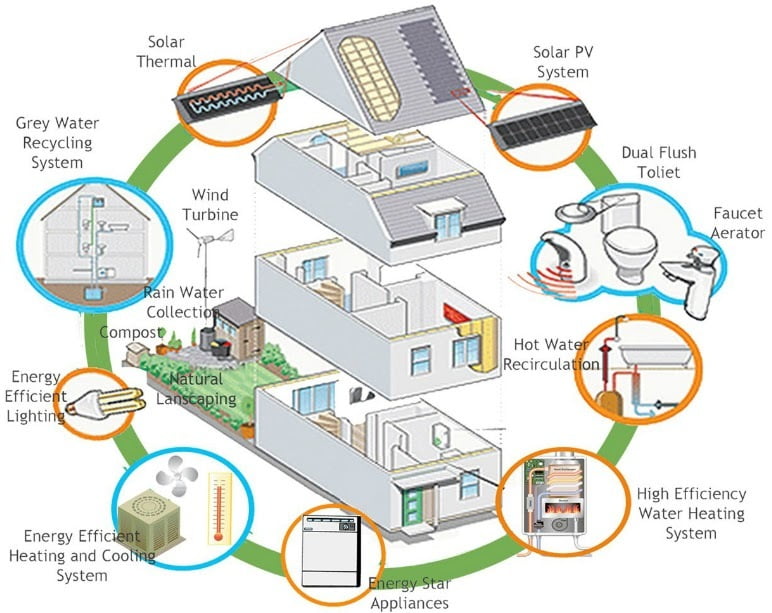The Questions a Home Buyer Should Really be Asking
The housing market may have had a rough time of late, but there are still plenty of us out there looking to buy a new home. Whether you are a first time buyer or a seasoned home-buying veteran, it is worth remembering that buying a house is one of the biggest decisions you can make, and not just financially. The location, size and style of your house, along with what you chose to do with it, can have a huge impact on the running cost and the ecological footprint of your home. So choose wisely, ask all the right questions, don’t fall for gimmicks, leave behind meaningless aspirations and check out some of my handy hints below. Happy hunting!
I cannot help but think in this chase for maximum amenities most developers and many more home buyers have completely lost sight of what constitutes a good home in the long term. A good home should ensure comfort, health & well-being, convenience, resilience, safety, durability, environmental sustainability and most importantly it should be easy on the pockets when it comes to maintenance, energy bills and costs/hassles associated with water.
It is absolutely pointless to get too excited about the amenities mentioned above as all of them are practically useless if not maintained to the best of standards. In almost every residential development home buyers soon begin to realize what a huge financial burden these amenities are and the cost of maintaining them just goes higher every year. All these amenities also require well paid, trained personnel to ensure safe use. Do we really want our children to be playing around swimming pools or gymnasiums with heavy equipment without adult supervision? Less than 5% of the residents in any colony use these amenities and yet everyone has to pay for their maintenance. It is almost always cheaper, safer and more socially rewarding to get a membership at a local health club or pay per use if that is an option. Hence, the likelihood of any of these amenities being in use for more than two years after occupancy is very slim.

Most amenities are just tools used by promoters to make a development look attractive to home buyers as these aspects of a development are visible and can be felt. But the real good qualities of any residential development lie in the bits not visible to us and require a little probing and prodding on the home buyer’s part. Here is a list of questions a home buyer should really be asking and these should be the areas of primary focus when buying a home:
Due to the constant demand supply gap, India is likely to remain a severely energy deficient country in the foreseeable future. When screening potential realtors, ask them how much they know about home energy performance and other environmental issues that matter to you. You can tell a lot just by taking a careful look around. Take a gander at the windows, and check if they're single or double-paned, and at the doors, to see if you feel a draft coming through around the edges. Never buy homes that are not fully day-lit or have too much direct sunlight coming into the home (in warm climates). Insist on energy efficiency measures like appropriate shading, cool roofs, high performance glazing, efficient lighting, controls etc. Power outages are here to stay and it is always better to have a home that can be comfortable without too much dependence on electrical appliances.
Have an understanding of the equipment on offer; inefficient lifts, pumps, motors, sewage treatment and RO plants are irreversible maintenance costs that hurt in the long run. It might even be worth bringing an energy expert to analyse these for you before making an investment.
Where is the water coming from and where is it going?
Most parts of our country are inevitably heading towards a major water crisis in the coming decade. It is only wise to insulate oneself form this oncoming crisis. Hence, one should never invest in a project that does not have a proper water management plan and seems unlikely to be prepared for drought situations. Check if the project is harvesting the maximum rainwater possible and is treating all its waste water on-site. Stored rainwater and treated wastewater can easily be reused for landscaping, flushing and external uses. The project must have installed water efficient low flow fixtures in bathrooms and kitchen. Water and energy are intrinsically linked so saving water saves energy as well. These measures can take care of up to 70% of your water needs leaving you to only worry about 30% in case of a sustained drought.
Does the home ensure a healthy indoor environment?
On average Indians spend more than 80% of their time indoors and the quality of the indoor environment has a huge bearing on our health, well-being and productivity. Never invest in a home that does not have enough fresh air ventilation and cross ventilation. Insist on fully operable windows and check if the window area is at least 13%-15% of the floor area. Look for exhaust systems in bathrooms and kitchen. Get a list of all the paints, varnishes and adhesives to be used in your home and ensure that these chemicals are eco-friendly and free of toxic Volatile Organic Compounds. These chemicals may off gas for as long as five years and when coupled with poor ventilation, it causes the sick building syndrome. Never make compromises here as problems related to indoor environmental quality are very expensive to fix.
At the risk of preaching something I do not practice, I truly believe small really is the new big, and less is the new more. The smaller your living space, the less energy is needed to cool and light it, and the less you have to spend on utilities too. With some thoughtful, careful interior design, you can create beautiful living environments out of some surprisingly small spaces. Smaller homes are likely to be better maintained and hence command a higher resale value per square foot compared to large homes.
How do I operate the house?
It never ceases to amaze me that a new house doesn't come with an owner's manual. You wouldn't expect a new car to come without guidance how to operate and maintain it; shouldn't we expect the same with something we're spending ten or twenty times as much money on? This owner's manual should explain in English, such issues as how to operate and maintain heating and cooling equipment, the importance of cleaning out gutters, what homeowners' need to know about the various comfort features of a home, the names of products and materials used in constructing the house, and how to inspect for termites or other problems. A homeowner's manual is also a great place to aggregate all the information that comes with appliances, cooling equipment, and any other systems in the house.
One of the best and perhaps the least technically challenging method of judging a home is to check if the project has been certified GREEN. Today any developer has the option of getting their project certified GREEN from the Indian Green Building Council or The Energy Resources Institute. These certifications come with varying slabs which inform a home buyer how energy & water efficient the home really is. These certifications also require the project to have sustainable site planning, enhanced indoor environmental quality, use of non toxic environmentally friendly materials and onsite waste management. All these aspects are well documented and can be made available to the home buyers to ease the painful process of choosing the best home.
There is nothing to say that a project that does not have a certificate is not high performance, the fact is that there are many uncertified developments that take a stronger approach towards environmental performance than certified one's but who is to check this? It the duty of developers and promoters to help home buyers lead a comfortable, affordable and hassle free lifestyle. Any project must enable and encourage its residents to live in an environmentally responsible manner. It is the duty of the home buyers to buy responsibly, put in a little extra effort gathering project information and demand highest performance achievable within a budget.

